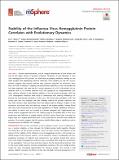| dc.contributor.author | Klein, Eili Y. | en_US |
| dc.contributor.author | Blumenkrantz, Deena | en_US |
| dc.contributor.author | Serohijos, Adrian | en_US |
| dc.contributor.author | Shakhnovich, Eugene | en_US |
| dc.contributor.author | Choi, Jeong-Mo | en_US |
| dc.contributor.author | Rodrigues, João V. | en_US |
| dc.contributor.author | Smith, Brendan D. | en_US |
| dc.contributor.author | Lane, Andrew P. | en_US |
| dc.contributor.author | Feldman, Andrew | en_US |
| dc.contributor.author | Pekosz, Andrew | en_US |
| dc.date.accessioned | 2018-02-26T20:46:05Z | |
| dc.date.issued | 2018 | en_US |
| dc.identifier.citation | Klein, Eili Y., Deena Blumenkrantz, Adrian Serohijos, Eugene Shakhnovich, Jeong-Mo Choi, João V. Rodrigues, Brendan D. Smith, Andrew P. Lane, Andrew Feldman, and Andrew Pekosz. 2018. “Stability of the Influenza Virus Hemagglutinin Protein Correlates with Evolutionary Dynamics.” mSphere 3 (1): e00554-17. doi:10.1128/mSphereDirect.00554-17. http://dx.doi.org/10.1128/mSphereDirect.00554-17. | en |
| dc.identifier.issn | | en |
| dc.identifier.uri | http://nrs.harvard.edu/urn-3:HUL.InstRepos:34869074 | |
| dc.description.abstract | ABSTRACT Protein thermodynamics are an integral determinant of viral fitness and one of the major drivers of protein evolution. Mutations in the influenza A virus (IAV) hemagglutinin (HA) protein can eliminate neutralizing antibody binding to mediate escape from preexisting antiviral immunity. Prior research on the IAV nucleoprotein suggests that protein stability may constrain seasonal IAV evolution; however, the role of stability in shaping the evolutionary dynamics of the HA protein has not been explored. We used the full coding sequence of 9,797 H1N1pdm09 HA sequences and 16,716 human seasonal H3N2 HA sequences to computationally estimate relative changes in the thermal stability of the HA protein between 2009 and 2016. Phylogenetic methods were used to characterize how stability differences impacted the evolutionary dynamics of the virus. We found that pandemic H1N1 IAV strains split into two lineages that had different relative HA protein stabilities and that later variants were descended from the higher-stability lineage. Analysis of the mutations associated with the selective sweep of the higher-stability lineage found that they were characterized by the early appearance of highly stabilizing mutations, the earliest of which was not located in a known antigenic site. Experimental evidence further suggested that H1N1 HA stability may be correlated with in vitro virus production and infection. A similar analysis of H3N2 strains found that surviving lineages were also largely descended from viruses predicted to encode more-stable HA proteins. Our results suggest that HA protein stability likely plays a significant role in the persistence of different IAV lineages. IMPORTANCE: One of the constraints on fast-evolving viruses, such as influenza virus, is protein stability, or how strongly the folded protein holds together. Despite the importance of this protein property, there has been limited investigation of the impact of the stability of the influenza virus hemagglutinin protein—the primary antibody target of the immune system—on its evolution. Using a combination of computational estimates of stability and experiments, our analysis found that viruses with more-stable hemagglutinin proteins were associated with long-term persistence in the population. There are two potential reasons for the observed persistence. One is that more-stable proteins tolerate destabilizing mutations that less-stable proteins could not, thus increasing opportunities for immune escape. The second is that greater stability increases the fitness of the virus through increased production of infectious particles. Further research on the relative importance of these mechanisms could help inform the annual influenza vaccine composition decision process. | en |
| dc.language.iso | en_US | en |
| dc.publisher | American Society for Microbiology | en |
| dc.relation.isversionof | doi:10.1128/mSphereDirect.00554-17 | en |
| dc.relation.hasversion | http://www.ncbi.nlm.nih.gov/pmc/articles/PMC5750392/pdf/ | en |
| dash.license | LAA | en_US |
| dc.subject | Ecological and Evolutionary Science | en |
| dc.subject | evolution | en |
| dc.subject | hemagglutinin | en |
| dc.subject | influenza | en |
| dc.subject | protein stability | en |
| dc.title | Stability of the Influenza Virus Hemagglutinin Protein Correlates with Evolutionary Dynamics | en |
| dc.type | Journal Article | en_US |
| dc.description.version | Version of Record | en |
| dc.relation.journal | mSphere | en |
| dash.depositing.author | Serohijos, Adrian | en_US |
| dc.date.available | 2018-02-26T20:46:05Z | |
| dc.identifier.doi | 10.1128/mSphereDirect.00554-17 | * |
| dash.contributor.affiliated | Rodrigues, Joao | |
| dash.contributor.affiliated | Shakhnovich, Eugene | |
| dash.contributor.affiliated | Serohijos, Adrian | |


